Top 10 Best Crypto Trading Exchanges
A crypto trading exchange is a marketplace — usually an app and website — where you convert one asset into another (for example, USD to BTC, or ETH to USDT) and manage orders such as market, limit, and stop-loss.
Under the hood, the exchange runs an order-matching engine, maintains user balances in custodial wallets, and connects to external liquidity (market makers, other venues) to keep prices competitive.
Some exchanges are centralized (CEXs), holding your assets and private keys on your behalf, while decentralized exchanges (DEXs) let you trade directly from your wallet via smart contracts.
Most beginners start on CEXs because they’re simpler and often support bank cards, local fiat rails, and customer support.
Choosing the right exchange matters because it affects three things that determine your real trading experience and risk: security, access, and cost.
Security includes how your funds and data are protected, whether the platform is solvent, and how it handles incidents. Access covers which coins, fiat deposits, and regions are supported, plus whether you can use advanced order types or derivatives if you need them.
Cost encompasses not just visible trading fees but also spreads, funding rates, and network withdrawal fees that quietly add up.
Cryptocurrency adoption has expanded from niche communities to mainstream investors, institutions, and payment providers.
That growth attracts both well-run, regulated platforms and fly-by-night operators. The risks of picking an unreliable venue are not abstract: poor wallet management can lead to hacks, opaque balance sheets can mask insolvency, aggressive leverage can magnify losses, and weak compliance can result in sudden service suspensions in your country.
Even on reputable platforms, user mistakes — like disabling two-factor authentication — can expose accounts to takeover attempts. An informed choice significantly reduces these risks.

What to expect from this series: we will focus on exchanges with strong track records for custody and security practices, transparent or clearly documented fees, deep liquidity on major pairs, and responsive support.
We will prioritize platforms that balance usability for newcomers with robust tooling for advanced traders, and that demonstrate credible adherence to applicable regulations in their operating regions.
Each exchange profile will clearly explain its strengths, trade-offs, and best-fit user, so you can map your needs — whether that’s low fees, a specific altcoin, derivatives access, or institutional features — to the right platform.
Finally, you’ll find practical guidance on safety and due diligence, because no list replaces personal responsibility: use exchanges as tools, not vaults, and verify before you trust.
Binance
Binance is a centralized cryptocurrency exchange launched in 2017 that offers one of the broadest product suites in the market: spot, margin, perpetual futures, options, copy trading, P2P, and token-launch participation.

It consistently ranks at or near the top by trading volume and liquidity on major data aggregators. Since November 2023 the exchange has operated under new leadership and a U.S. enforcement settlement that mandates enhanced compliance controls and an independent monitorship.
In 2024 its Dubai subsidiary, Binance FZE, received a full VASP license that permits service to retail, qualified, and institutional clients. Availability and specific features remain jurisdiction-dependent; Binance.com does not serve U.S. residents, who are instead directed to the separate Binance.US platform.
Binance Key Features
- Broad market access and liquidity
Deep order books across many spot and derivatives pairs; consistently high placement in independent exchange rankings. - Competitive, transparent fee structure
Tiered maker/taker schedules for spot and derivatives; additional discounts when paying fees with BNB. - Security posture and transparency
Standard controls (2FA, withdrawal address management), a public Proof-of-Reserves program using Merkle-tree verification, and the Secure Asset Fund for Users (SAFU), which Binance shifted to USDC in 2024 to stabilize its value. - Product breadth for different styles
Perpetuals and options, copy trading, a large P2P marketplace, and Launchpad/Launchpool participation for primary-market token access. - Compliance footprint and regional nuance
Post-settlement governance and licensing push (e.g., VARA license in Dubai). By contrast, the UK has long-standing FCA restrictions on regulated activity, and Binance.com is not available to U.S. users.
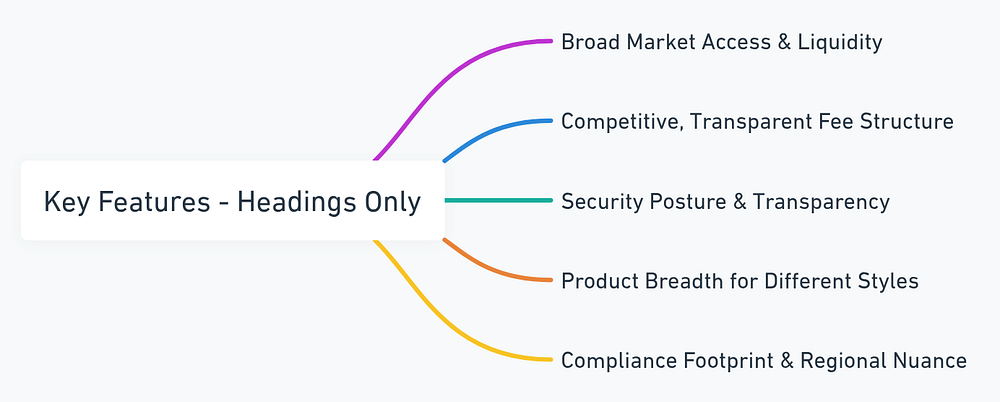
Binance Pros & Cons
Binance Pros
- Industry-leading liquidity and market coverage for both spot and derivatives
- Low headline trading fees with meaningful BNB/VIP discounts
- Public PoR plus a ring-fenced SAFU emergency fund
- Wide feature set in a single platform (copy trading, P2P, Launchpool)
Binance Cons
- Regulatory complexity and uneven feature availability across regions (e.g., U.S., UK, and EU rule changes)
- Historical security incidents (notably a 2019 hot-wallet breach) underscore the need for strong user-side security
- MiCA-driven stablecoin restrictions for EEA users change the available pairs and products over time
Binance is Best For
- Traders who prioritize deep liquidity, tight spreads, and broad market access
- Fee-sensitive, higher-volume users who benefit from VIP tiers and BNB fee discounts
- Global users in supported regions who want an all-in-one venue with both passive-earn and active-trading tools
Binance Rating (out of 5)
- Security & Transparency: 4.4
- Fees: 4.8
- Liquidity & Market Coverage: 4.9
- Features: 4.8
- Compliance Footprint: 3.9
- Overall: 4.6/5

Final Verdict on Binance — Binance remains a top-tier choice for most active traders because of its depth, breadth, and costs. The platform’s security tooling, PoR reporting, and SAFU fund are strong positives, and product coverage is hard to match.
The trade-off is regulatory complexity: eligibility, stablecoin access in the EEA, leverage limits, and certain features can change based on your country and account tier.
If Binance serves your jurisdiction with the products you need, it is one of the most capable all-round exchanges; just practice good operational security and verify the exact fee and product terms shown in your account.
Coinbase
Coinbase is a U.S.-based, publicly listed cryptocurrency company (ticker: COIN) offering a regulated spot exchange, institutional prime brokerage and custody, and, increasingly, derivatives access.
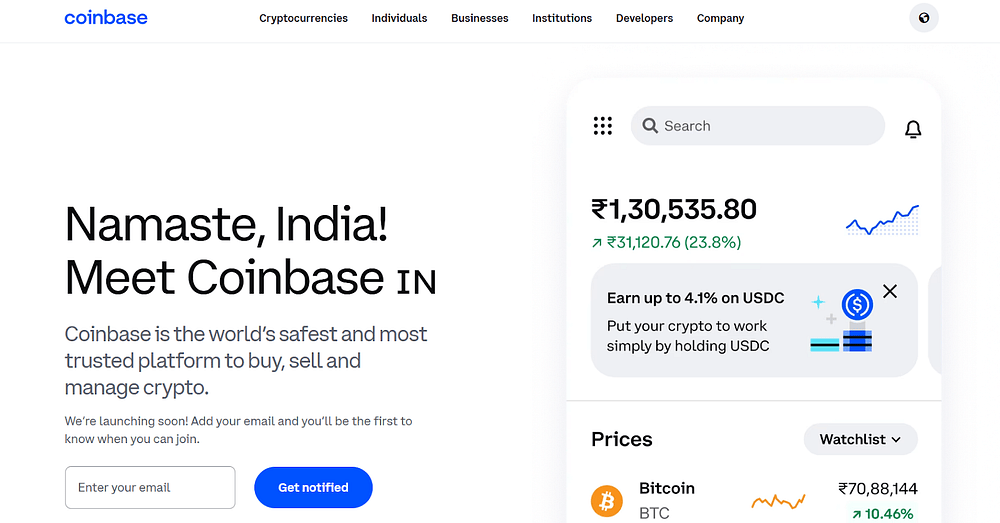
In May 2023 it launched Coinbase International Exchange in Bermuda for non-U.S. customers; in 2023–2025 it expanded regulated futures access via Coinbase Financial Markets in the U.S.
Following a policy shift in 2025, the U.S. SEC formally dismissed its civil enforcement action against Coinbase. Availability and product sets vary by jurisdiction.
Coinbase Key Features
- Regulated footprint and disclosures
Public-company reporting (annual 10-K, quarterly updates) with stated segregation of customer crypto assets from corporate assets. Coinbase Custody Trust maintains SOC 1 Type II and SOC 2 Type II audits by a Big Four auditor; staking services achieved SOC 2 Type 1. - Spot and advanced trading
“Coinbase” app for simplicity and Advanced Trade for pro workflows, including bracket/conditional orders. A transparent maker-taker fee schedule applies on the Exchange/Advanced venues; the consumer app uses a spread plus fees disclosed at checkout. - Derivatives
Perpetual-style futures for non-U.S. clients on Coinbase International (BMA Class F license), and CFTC-regulated U.S. futures access via Coinbase Financial Markets with “US perpetual-style” contracts rolling out in July 2025. - Institutional stack
Coinbase Prime for execution, custody, and financing, with audited controls and institutional reporting. - Compliance and legal posture
SEC case dismissed in Feb. 2025; Coinbase publishes an enforcement docket and continues operating under U.S. and international regulatory regimes.

Coinbase Pros & Cons
Coinbase Pros
- Strong regulatory posture for a crypto exchange (public filings, audited controls, custody segregation).
- Clean, beginner-friendly UX with a path to Advanced Trade; broad U.S. fiat on-ramps.
- Growing derivatives access both internationally and in the U.S., under dedicated regulated entities.
- Robust institutional services (Prime, Custody) with third-party audits.
Coinbase Cons
- Headline trading fees on the consumer app can be higher than pro/advanced tiers; effective costs vary by venue.
- Asset selection is more conservative than some offshore exchanges.
- Certain products, pairs, and leverage levels are restricted by jurisdiction and account tier.
Coinbase is Best For
- Beginners who want a straightforward on-ramp with strong disclosures.
- Advanced spot traders who prefer a regulated venue with solid APIs and order types.
- Institutions needing audited custody and reporting.
- Derivatives traders who want regulated access (International for non-U.S.; CFM for U.S. products as they expand).
Coinbase Rating (out of 5)
- Security & Transparency: 4.7
- Fees: 4.0
- Liquidity & Market Coverage: 4.4
- Features: 4.5
- Compliance Footprint: 4.8
- Overall: 4.5/5

Final Verdict on Coinbase — Coinbase’s biggest advantages are regulatory clarity, public-company transparency, and polished user experience.
You’ll likely pay more than the absolute lowest-fee offshore venues, but you gain strong disclosures, audited controls, and steadily expanding product breadth, including regulated derivatives.
For users who prioritize compliance and reliability — especially in the U.S. and for institutions — Coinbase is a top-tier choice. Power users should use Advanced Trade (or International/Prime where eligible) to optimize fees and functionality.
Bybit
Bybit, founded in 2018 and headquartered in Dubai, has grown into one of the largest global derivatives-focused cryptocurrency exchanges.

It initially built its reputation around perpetual contracts and leverage trading but has since expanded to include spot markets, staking/earn products, a launchpad for token sales, and copy trading.
Bybit serves over 20 million users in 160+ countries, though it restricts access in some jurisdictions, including the U.S., Canada (Québec, Ontario), Singapore, and certain European countries due to local regulations.
Bybit Key Features
- Derivatives Expertise
Strong lineup of perpetual and futures contracts with leverage up to 100x on BTC pairs (lower for other assets), backed by a robust matching engine designed for low latency and high throughput. - Spot Trading & Liquidity
Hundreds of spot pairs with competitive fees (maker 0.1%, taker 0.1%, with VIP discounts), plus deep order books for major assets. - Earn & Passive Income
Flexible savings, dual-asset mining, liquidity mining, and launchpool/launchpad access to new projects. - copy tradingA large copy trading community where followers can mirror strategies of ranked traders, with transparent performance stats.
- Security
Cold wallet storage for most funds, multi-signature withdrawal process, 2FA, withdrawal whitelist, and a dedicated insurance fund for derivatives to manage liquidation risk. - User Experience
Modern interface for both web and mobile; advanced order types including TP/SL pre-set orders, conditional orders, and iceberg orders. API support for algorithmic traders.
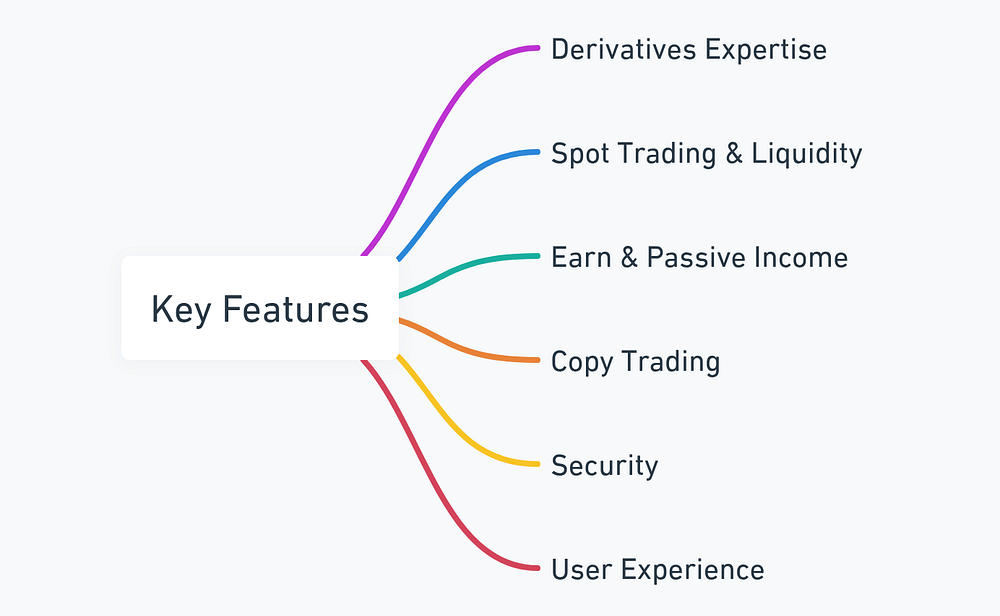
Bybit Pros & Cons
Bybit Pros
- Industry-leading derivatives liquidity and order execution speed.
- Competitive spot and derivatives fees, with additional discounts for high-volume traders.
- Strong security framework and transparent insurance fund for contract trading.
- Diverse passive income products and active token launchpad participation.
- Copy trading feature appeals to beginners wanting to follow experienced traders.
Bybit Cons
- Not available in key markets like the U.S. and Singapore.
- High leverage poses risk for inexperienced traders.
- Asset range, especially for smaller altcoins, is narrower than on some altcoin-heavy exchanges.
- Regulatory uncertainty in certain regions could affect future availability.
Bybit is Best For
- Advanced derivatives traders who want deep liquidity and low-latency execution.
- Intermediate spot traders seeking a balance between competitive fees and product variety.
- Passive income seekers interested in staking, liquidity mining, and token launches.
- Beginners who want to learn through copy trading without starting from scratch.
Bybit Rating (out of 5)
- Security & Transparency: 4.5
- Fees: 4.6
- Liquidity & Market Coverage: 4.7
- Features: 4.7
- Compliance Footprint: 3.8
- Overall: 4.5/5
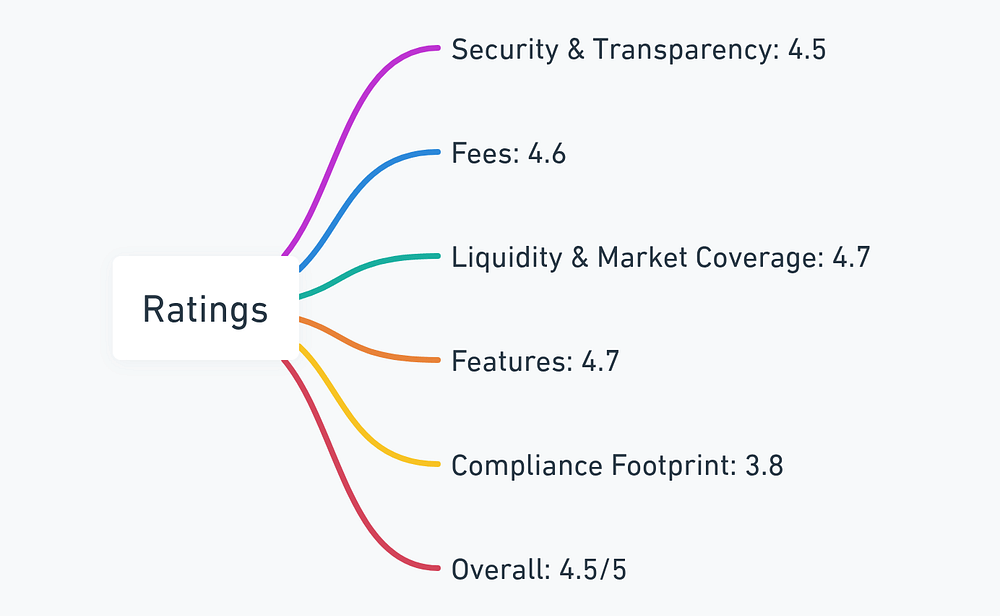
Final Verdict — Bybit has cemented its position as a go-to platform for derivatives trading while building out a solid spot and earn ecosystem. It offers strong liquidity, modern UX, and innovative products like copy trading and launchpads.
The main trade-offs are its limited geographic availability and the inherent risks of high-leverage products.
For traders in supported regions — especially those focused on perpetuals — Bybit is one of the most capable and well-rounded choices.
OKx
OKx, founded in 2017 and headquartered in Seychelles with regional hubs in Hong Kong, Dubai, and Singapore, is one of the largest global cryptocurrency exchanges by trading volume.

It offers spot trading, perpetual and futures contracts, options, DeFi services, an integrated Web3 wallet, and a launchpad for new token offerings.
The platform serves over 50 million users in 180+ countries but does not operate in the U.S. or several other restricted jurisdictions due to regulatory constraints. OKX has also positioned itself as a bridge between centralized and decentralized finance with its in-app DEX and NFT marketplace.
OKX Key Features
- Comprehensive Trading Products
Spot markets for hundreds of crypto pairs, derivatives with leverage up to 125x on select contracts, and a liquid options market for BTC and ETH. - Web3 Wallet Integration
Built-in multi-chain OKX Wallet that supports DeFi protocols, NFT trading, and token swaps directly from within the app or browser extension. - Earn & DeFi Hub
Offers flexible savings, fixed-term staking, liquidity farming, dual investment products, and access to DeFi yield opportunities. - Advanced Trading Tools
Customizable interface, advanced charting, algo orders (TWAP, iceberg, stop-limit), portfolio margining, and powerful API access for professional traders. - Security
Cold and hot wallet separation, multi-signature authorization, semi-offline multi-party computation (MPC) custody, 2FA, and anti-phishing codes. Regularly publishes Proof-of-Reserves using a Merkle-tree approach. - Launchpad & Jumpstart
Early access to vetted token projects through its Jumpstart program, with subscription and lottery allocation models.

OKX Pros & Cons
OKX Pros
- Deep liquidity in both spot and derivatives markets.
- Integrated Web3 wallet and NFT marketplace for DeFi-native users.
- Diverse yield products with flexible and fixed terms.
- Regular Proof-of-Reserves audits for transparency.
- Competitive fee structure with maker/taker discounts for high-volume traders.
OKX Cons
- Not available in the U.S. and certain restricted jurisdictions.
- Wide product range can overwhelm new users.
- Leverage up to 125x can be risky for inexperienced traders.
- Regulatory changes in Asia and Europe could impact service scope.
OKX is Best For
- Active derivatives traders seeking high leverage and deep liquidity.
- DeFi and Web3 enthusiasts who want integrated wallet and NFT support.
- Yield-focused investors using OKX Earn for staking and dual investment strategies.
- Advanced traders who need customizable workspaces and algorithmic order types.
OKX Rating (out of 5)
- Security & Transparency: 4.6
- Fees: 4.6
- Liquidity & Market Coverage: 4.8
- Features: 4.8
- Compliance Footprint: 3.9
- Overall: 4.5/5

Final Verdict on OKX— OKX blends a powerful centralized exchange with a built-in Web3 ecosystem, making it attractive for both traders and DeFi-native users.
Its liquidity, advanced features, and Proof-of-Reserves program inspire confidence, but regional restrictions and the complexity of its product set mean it’s best suited for experienced users comfortable navigating both CEX and DeFi tools.
For those in supported jurisdictions, it’s a top-tier all-in-one platform.
BingX
BingX, founded in 2018 and headquartered in Singapore, is a global cryptocurrency exchange offering spot, derivatives, copy trading, and social trading features. It has grown rapidly in emerging markets, particularly in Asia, Latin America, and Eastern Europe.

BingX serves over 10 million users across 100+ countries, although it is not available in certain restricted jurisdictions, including the United States, Singapore, and several sanctioned regions.
The platform emphasizes accessibility, beginner-friendly tools, and social interaction between traders.
BingX Key Features
- Copy Trading & Social Features
One of BingX’s flagship offerings, allowing users to follow and automatically replicate trades from professional or high-performing traders. Includes performance rankings, win rate stats, and risk profiles. - Spot & Derivatives Trading
Supports hundreds of spot pairs and perpetual/futures contracts with leverage up to 150x for select products. Offers both USDT-margined and coin-margined contracts. - Grid & Automated Trading
Built-in grid trading bots and strategy tools to automate trades within user-defined parameters, available for both spot and futures markets. - Demo TradingFree simulated trading environment to test strategies without risking real funds — ideal for beginners.
- Earn ProductsFlexible and fixed-term savings, staking, and promotional yield campaigns for select tokens.
- Security
Cold wallet storage for most assets, two-factor authentication (2FA), withdrawal address whitelisting, and anti-phishing codes. - User Experience
Simple UI designed for newcomers, available in multiple languages, with lightweight mobile apps optimized for low-bandwidth environments.
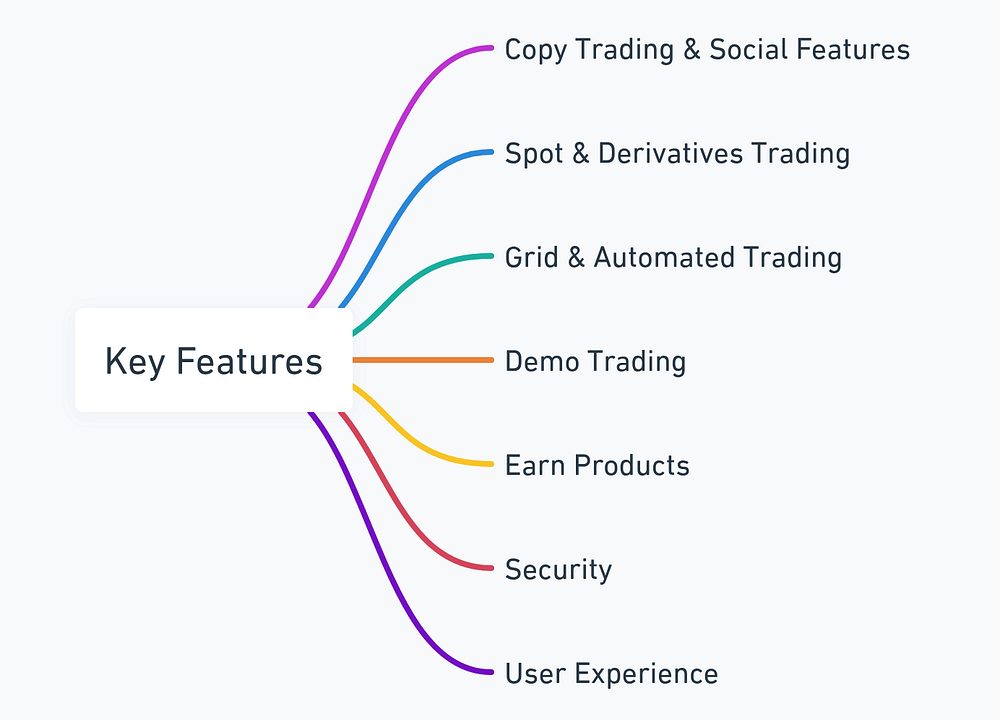
BingX Pros & Cons
BingX Pros
- Strong focus on copy trading and social engagement tools.
- Variety of trading products including spot, futures, and automated bots.
- Demo mode helps onboard beginners without financial risk.
- Wide geographical reach in emerging markets.
- Competitive fee structure compared to similar exchanges.
BingX Cons
- Not available in major markets like the U.S. and Singapore.
- Less liquidity than top-tier exchanges for certain pairs, which can impact large orders.
- Leverage up to 150x increases risk, especially for inexperienced users.
- Regulatory framework less established compared to exchanges with multiple major licenses.
BingX is Best For
- Beginners who want to learn through demo trading and copy experienced traders.
- Social trading enthusiasts looking to interact and share strategies.
- Emerging market traders seeking a multilingual, lightweight trading platform.
- Intermediate derivatives traders comfortable with moderate-to-high leverage.
BingX Rating (out of 5)
- Security & Transparency: 4.2
- Fees: 4.5
- Liquidity & Market Coverage: 4.2
- Features: 4.6
- Compliance Footprint: 3.7
- Overall: 4.3/5

Final Verdict on BingX — BingX distinguishes itself with its social and copy trading features, making it a great entry point for beginners and an engaging platform for experienced traders who want to share strategies.
While it may not match the liquidity or compliance profile of tier-1 exchanges, it offers a solid, user-friendly experience — particularly for traders in supported emerging markets.
BYDFi
BYDFi (Build Your Dream Finance), established in 2020 and headquartered in Singapore, is a centralized cryptocurrency exchange that focuses on accessibility for beginners and compliance in multiple regions.

It offers spot, derivatives, and copy trading, alongside fiat on/off ramps that support a wide range of local payment methods. BYDFI positions itself as a platform for global retail traders, particularly in emerging markets, while maintaining regulatory registrations in the U.S., Canada, Australia, and parts of Asia.
Its name reflects its stated mission to provide tools for traders to “build their dream” in finance.
BYDFi Key Features
- Spot & Derivatives Trading
Supports trading in hundreds of cryptocurrencies, with derivatives contracts offering leverage up to 100x. Products include USDT-margined and coin-margined perpetuals. - Copy Trading
A curated system where users can follow experienced traders, view their performance history, and automatically replicate their trades. - Fiat Gateway
Supports multiple fiat currencies and payment methods, including credit/debit cards, bank transfers, and regional payment systems. - Security
Cold storage for the majority of user funds, SSL encryption, 2FA, and withdrawal address whitelisting. - Regulatory Registrations
Registered as an MSB (Money Services Business) with the U.S. FinCEN, FINTRAC in Canada, and holds licensing in Australia under AUSTRAC, signaling an effort to comply with AML/KYC standards. - User-Friendly Interface
Intuitive web and mobile platforms designed for retail traders with simplified navigation and multilingual support.

BYDFi Pros & Cons
BYDFi Pros
- Simple onboarding and user-friendly interface for new traders.
- Licensed or registered in multiple jurisdictions, boosting trust.
- Copy trading for learning and passive participation.
- Supports diverse fiat payment methods across regions.
BYDFi Cons
- Smaller trading volume and liquidity compared to tier-1 exchanges.
- Fewer advanced features for institutional or high-frequency traders.
- Leverage products may pose risks for inexperienced users.
- Limited product diversity outside of spot, futures, and copy trading.
BYDFi is Best For
- Beginners who value a clean interface and easy onboarding.
- Traders in emerging markets seeking multiple fiat deposit options.
- Copy trading users who want to follow vetted, high-performing traders.
- Retail derivatives traders comfortable with moderate leverage.
BYDFi Rating (out of 5)
- Security & Transparency: 4.1
- Fees: 4.3
- Liquidity & Market Coverage: 4.0
- Features: 4.2
- Compliance Footprint: 4.4
- Overall: 4.2/5

Final Verdict on BYDFi — BYDFi focuses on simplicity, compliance, and accessibility, making it a strong entry point for retail traders who want straightforward spot and derivatives trading plus the option to follow experienced traders.
While it doesn’t match the liquidity or institutional-grade features of the largest exchanges, its regulatory registrations and easy fiat integration make it a trustworthy choice for users in supported regions.
MEXC
MEXC (originally MXC Exchange), founded in 2018 and headquartered in Seychelles, is a centralized cryptocurrency exchange known for its extensive range of listed assets, especially mid-cap and low-cap altcoins.
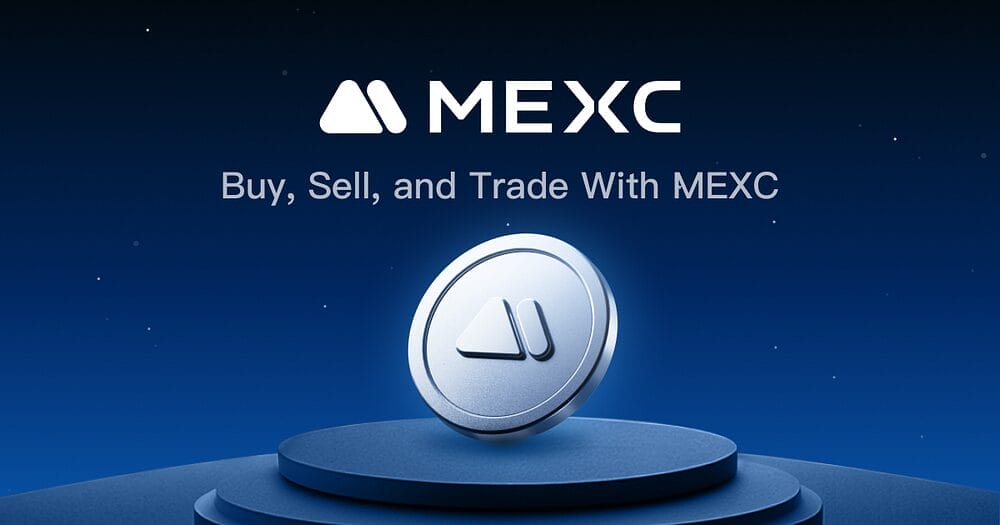
It serves users in over 170 countries and is popular among traders seeking early access to new tokens. MEXC offers spot, margin, futures, and ETF-like leveraged tokens, along with staking and launchpad participation.
While it is globally accessible, it restricts service in certain jurisdictions, including the United States, due to regulatory requirements.
MEXC Key Features
- Extensive Asset Selection
Offers thousands of trading pairs, including newly launched tokens that may not be available on larger exchanges. - Spot & Derivatives Markets
Supports USDT-margined and coin-margined perpetual contracts with leverage up to 200x on select products. - Leveraged ETFs
Provides ETF-like tokens (e.g., BTC3L for 3x long Bitcoin) that allow leveraged exposure without margin maintenance or liquidation in the traditional sense. - Launchpad & Kickstarter Events
Access to early token sales and community-voting events that determine new listings. - Staking & Earn
Flexible and fixed-term staking, DeFi yield aggregation, and promotional APYs for specific assets. - Security
Cold/hot wallet segregation, multi-signature systems, 2FA, anti-phishing codes, and regular internal audits. - Fee Structure
Competitive maker/taker rates starting at 0% maker and 0.1% taker for spot trading, with futures fees typically around 0.02% maker / 0.06% taker.

MEXC Pros & Cons
MEXC Pros
- Massive range of listed assets, including niche altcoins.
- Low fees, with promotional zero-maker-fee campaigns.
- High leverage options for derivatives traders.
- Frequent token launches and early listing opportunities.
- Earn products with competitive APYs.
MEXC Cons
- Smaller brand recognition compared to Binance or OKX in institutional circles.
- High leverage and illiquid altcoins can increase risk.
- Not available to U.S. users.
- Proof-of-Reserves transparency is less developed than top-tier exchanges.
MEXC is Best For
- Altcoin hunters looking for early access to new and niche tokens.
- High-frequency and derivatives traders seeking low fees and high leverage.
- Yield seekers interested in staking and promotional APYs.
- Active traders who thrive on frequent token launches.
MEXC Rating (out of 5)
- Security & Transparency: 4.0
- Fees: 4.6
- Liquidity & Market Coverage: 4.5 (varies widely by pair)
- Features: 4.4
- Compliance Footprint: 3.8
- Overall: 4.3/5
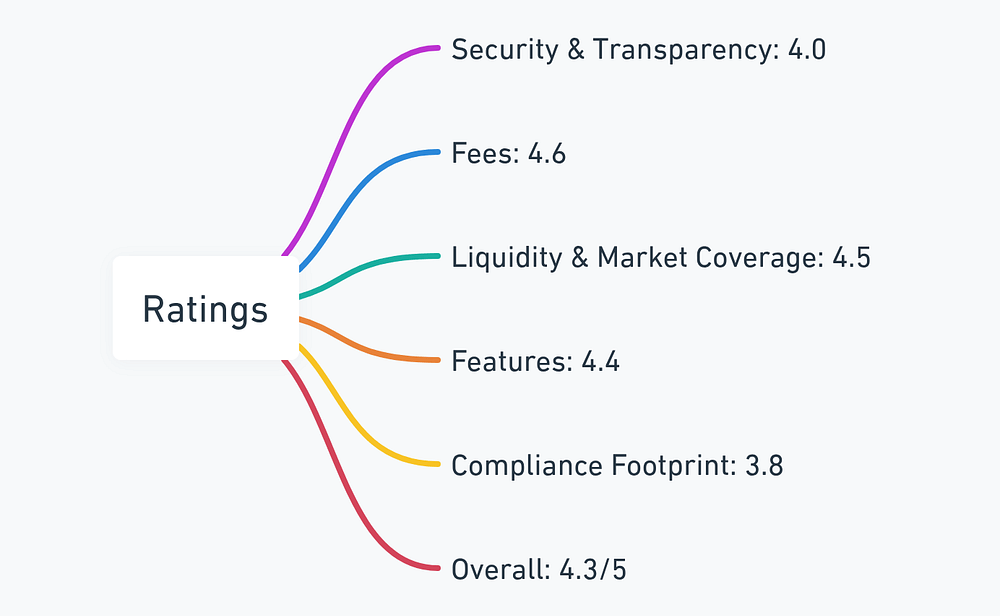
Final Verdict on MEXC — MEXC excels in asset variety, low fees, and frequent token launches, making it a hotspot for altcoin traders.
Its derivatives offering is competitive, but users should be mindful of liquidity in smaller pairs and the risks associated with high leverage.
While it may not yet match the institutional trust of the largest exchanges, for retail traders seeking a wide asset range and aggressive trading opportunities, MEXC is a strong option in supported regions.
Pionex
Pionex, launched in 2019 and headquartered in Singapore, is a centralized cryptocurrency exchange built around integrated trading bots.

It differentiates itself by offering automated strategies directly on the platform without requiring external API connections or third-party software.
The exchange provides both spot and leveraged trading, supports a moderate range of cryptocurrencies, and caters primarily to retail traders who want to automate trades with minimal technical setup.
Pionex serves users in over 100 countries but is not available in some jurisdictions, including the United States.
Pionex Key Features
- Built-in Trading Bots
Offers 16+ free automated trading bots, including grid trading, DCA (dollar-cost averaging), rebalancing, arbitrage, and trailing take-profit bots. These run on Pionex’s servers, removing the need for manual trade execution. - Spot & Leveraged Trading
Supports spot markets with competitive liquidity, plus leveraged tokens that provide 2–4x exposure without traditional margin liquidation risks. - Low Fees
Flat maker/taker fees of 0.05% for spot trading, lower than many major exchanges. - Mobile-First Design
Intuitive mobile and web platforms with simplified bot setup, performance tracking, and risk control features. - Liquidity Aggregation
Sources liquidity from major exchanges like Binance and Huobi, which can help ensure tighter spreads and better fills. - Security
Cold wallet storage, 2FA, withdrawal whitelists, and encrypted account protection. Also integrates risk-control mechanisms for bot operation.

Pionex Pros & Cons
Pionex Pros
- Multiple free trading bots built in — no coding required.
- Low, flat trading fees.
- Liquidity aggregation from larger exchanges improves execution.
- User-friendly interface tailored for automation beginners.
- Supports leveraged tokens for amplified exposure without margin maintenance.
Pionex Cons
- Limited coin selection compared to top-tier exchanges.
- Lacks advanced derivatives like perpetual contracts and options.
- No service for U.S. residents.
- Smaller institutional presence and fewer professional-grade tools beyond automation.
Pionex is Best For
- Retail traders who want easy-to-use automated strategies.
- Beginners looking to explore crypto trading without building bots from scratch.
- Passive traders seeking to DCA, grid trade, or rebalance without constant monitoring.
- Cost-conscious users who value low flat fees.
Pionex Rating (out of 5)
- Security & Transparency: 4.2
- Fees: 4.7
- Liquidity & Market Coverage: 4.0
- Features: 4.5
- Compliance Footprint: 3.9
- Overall: 4.3/5

Final Verdict — Pionex is a niche-focused exchange ideal for traders who want integrated, automated strategies without technical complexity.
Its low fees and liquidity aggregation make it competitive for spot trading, though its product range is narrower than larger exchanges.
For users who prioritize hands-off, bot-driven approaches, Pionex delivers a ready-made automation toolkit in a single platform.
Kucoin
KuCoin, launched in 2017 and headquartered in Seychelles, is a global cryptocurrency exchange known for its wide range of listed assets and competitive fee structure.

It serves over 30 million users in more than 200 countries and is often referred to as the “People’s Exchange” due to its accessibility and focus on altcoins. KuCoin offers spot, margin, derivatives, P2P trading, staking, and an integrated trading bot marketplace.
While it operates internationally, KuCoin does not hold major regulatory licenses in the U.S. and has faced scrutiny from regulators in certain jurisdictions.
Kucoin Key Features
- Extensive Asset Selection
Supports 700+ cryptocurrencies and 1,200+ trading pairs, including many low-cap and newly listed altcoins. - Spot, Margin, and Derivatives Trading
Offers up to 10x leverage on margin trades and up to 100x on futures contracts. Both USDT- and coin-margined perpetuals are available. - Trading Bots
Integrated grid, DCA, infinity grid, and smart rebalance bots, as well as futures bots for automated strategies. - KuCoin Earn
Flexible savings, fixed-term staking, promotions, and dual investment products with competitive yields. - KCS Token Ecosystem
Holders of KuCoin Token (KCS) receive trading fee discounts, daily bonus payouts from the platform’s revenue, and higher VIP tier benefits. - Security
Cold and hot wallet segregation, multi-factor authentication, withdrawal address whitelists, and an insurance fund to cover certain incidents. KuCoin also suffered a major hack in 2020 (~$280M) but recovered most funds through tracking and partnerships. - P2P Marketplace
Supports local fiat transactions via escrow, offering access to multiple payment methods.

Kucoin Pros & Cons
Kucoin Pros
- Huge selection of assets, including niche and early-stage tokens.
- Competitive fees with further reductions for KCS holders.
- Built-in trading bots for automated strategies.
- Robust earn and staking options.
- Active P2P fiat gateway.
Kucoin Cons
- Not licensed in major jurisdictions like the U.S., UK, or EU.
- Past major security breach (2020), though resolved.
- Some pairs have lower liquidity compared to top-tier exchanges.
- Geographic restrictions limit certain features.
Kucoin is Best For
- Altcoin traders seeking access to a wide range of assets.
- Cost-conscious traders who want low fees and token-based discounts.
- Bot users looking for integrated automated strategies.
- Yield seekers using staking and earn products.
Kucoin Rating (out of 5)
- Security & Transparency: 4.1
- Fees: 4.6
- Liquidity & Market Coverage: 4.5
- Features: 4.6
- Compliance Footprint: 3.7
- Overall: 4.3/5

Final Verdict on Kucoin — KuCoin is a leading choice for traders seeking broad asset access, competitive fees, and integrated automation tools. It’s particularly attractive to altcoin hunters and yield seekers.
However, its limited regulatory licensing and history of a major hack mean it’s best suited for experienced traders who understand counterparty risk and use secure custody practices for long-term holdings.
Gate.io
Gate.io, founded in 2013 and headquartered in the Cayman Islands, is one of the oldest cryptocurrency exchanges still in operation.

Known for its extensive asset listing and strong presence in Asia, Gate.io offers spot, margin, derivatives, ETF-like leveraged products, staking, startup token sales, and NFT trading.
The platform lists thousands of trading pairs, including many low-cap altcoins, making it a go-to venue for early-access token traders. While global in reach, it restricts access in certain jurisdictions, including the U.S., Canada, and Singapore, due to regulatory requirements.
Gate.io Key Features
- Extensive Asset Listing
Supports over 1,700 cryptocurrencies and 2,900+ trading pairs, making it one of the largest selections in the industry. - Spot, Margin, and Derivatives Trading
Margin trading with leverage up to 10x; perpetual contracts with leverage up to 100x. - Leveraged ETFs
Provides ETF-like tokens (e.g., BTC3L for 3x long Bitcoin) for leveraged exposure without traditional margin maintenance. - Startup Launchpad
Hosts initial token offerings via its “Startup” platform, giving users early access to vetted projects. - Gate Earn
Offers flexible savings, fixed-term staking, liquidity mining, and structured products with varying yields. - Security
Cold/hot wallet segregation, multi-signature systems, 2FA, anti-phishing codes, and real-time monitoring. Publishes Proof-of-Reserves data periodically. - NFT Marketplace
Integrated platform for creating, buying, and selling NFTs across multiple chains. - Fee Structure
Maker/taker spot fees start at 0.2% with reductions for higher volumes or GT token holdings.
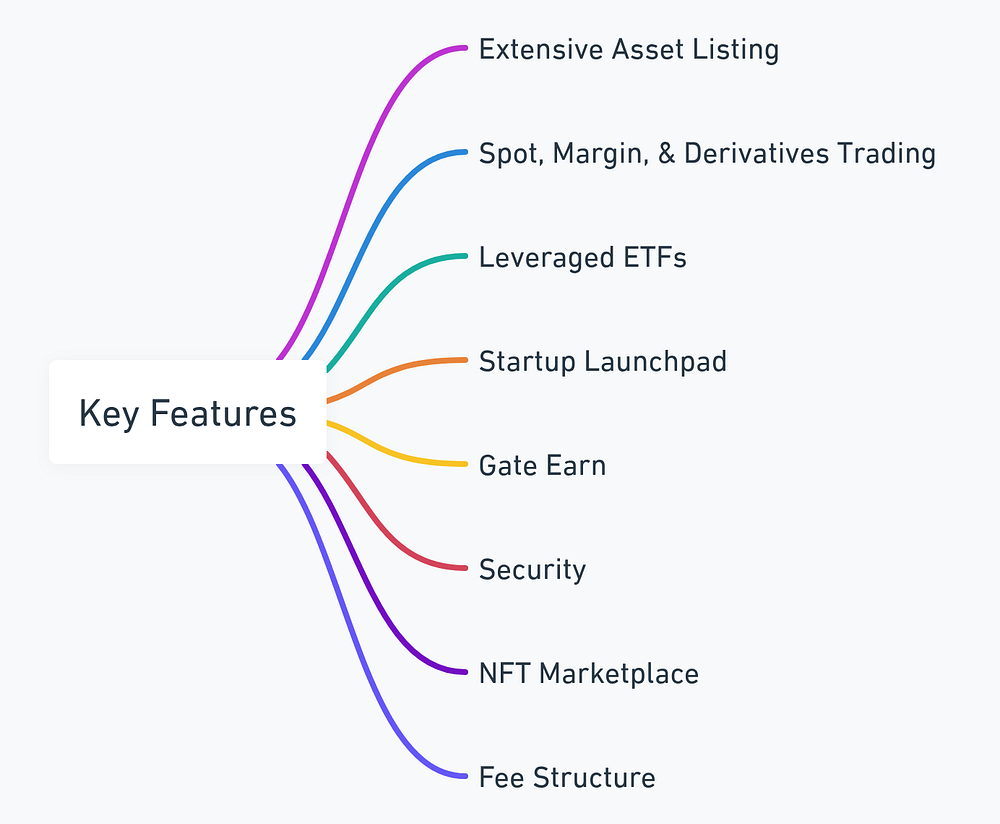
Gate.io Pros & Cons
Gate.io Pros
- Massive selection of coins and trading pairs, including niche projects.
- Diverse product offerings (spot, derivatives, ETFs, staking, NFTs).
- Active token launchpad with frequent new listings.
- Integrated NFT marketplace and DeFi access.
- Competitive fees with GT token discounts.
Gate.io Cons
- Not licensed in major Western jurisdictions like the U.S. or UK.
- High number of illiquid tokens — can pose risk to inexperienced traders.
- Complex interface may overwhelm beginners.
- Regulatory uncertainty in some operating regions.
Gate.io is Best For
- Altcoin hunters who want access to a wide range of assets before they hit larger exchanges.
- Active traders seeking both spot and derivatives markets with leverage.
- Yield seekers interested in staking, liquidity mining, and structured products.
- NFT traders wanting an integrated marketplace within a CEX.
Gate.io Rating (out of 5)
- Security & Transparency: 4.1
- Fees: 4.4
- Liquidity & Market Coverage: 4.6
- Features: 4.7
- Compliance Footprint: 3.7
- Overall: 4.3/5

Final Verdict — Gate.io is a veteran exchange that stands out for its massive asset coverage and variety of products.
It’s particularly attractive to altcoin traders and users seeking exposure to emerging tokens via its Startup launchpad.
However, its lack of licensing in certain regions and the presence of many illiquid assets mean it’s best suited for experienced traders who can manage risk and navigate a complex interface.
Best Crypto Trading Exchanges Comparison

Notes
- “Supported Coins” and fee baselines are rounded from public dashboards/fee pages. Pairs and exact rates change frequently by tier, token class, and promo.
- “Security Features” lists verifiable public programs (e.g., Proof-of-Reserves, user-protection funds) plus standard controls like 2FA; always verify current implementations.
How to Choose the Right Exchange for You?
Choosing the right crypto exchange is a balance of matching the platform’s strengths to your trading style, understanding the risks, and verifying credibility before committing funds.
Match Features to Your Trading Style
Day traders and scalpers
- Look for exchanges with deep liquidity on the pairs you trade, low-latency execution, and competitive maker/taker fees.
- Priority: fast matching engine, advanced order types (OCO, trailing stops), and reliable uptime during volatile markets.
- Examples: Binance, Bybit, OKX.
Swing traders and active investors
- Favor platforms with reasonable fees, a broad asset selection, and solid charting tools.
- Priority: access to both majors and promising altcoins, plus decent liquidity in mid-cap assets.
- Examples: KuCoin, Gate.io, MEXC.
Long-term holders (HODLers)
- Seek exchanges with strong custody practices, clear Proof-of-Reserves, and easy fiat on/off ramps.
- Priority: security, compliance, and simple user experience; ability to withdraw easily to cold storage.
- Examples: Coinbase, Binance, OKX.
Yield-focused users
- Choose exchanges with staking, lending, or dual investment products.
- Priority: verify whether yields are on-chain or internal, understand lock-up terms, and confirm counterparty risk.
- Examples: OKX Earn, KuCoin Earn, Gate.io Earn.
Automation & hands-off strategies
- Look for built-in trading bots or easy API access.
- Priority: bot diversity, reliability, and clear fee structure for automated trading.
- Examples: Pionex, KuCoin.

Warnings About Scams and Unregulated Platforms
- Unlicensed operators may disappear with funds or be shut down suddenly. Always check if an exchange is registered or licensed in your jurisdiction.
- Fake exchanges can mimic well-known brands — verify domain names and check for SSL certificates.
- Ponzi-style yield schemes often promise unrealistic returns (e.g., “guaranteed 50% per month”).
- Social media impersonators may pose as support staff or influencers to solicit deposits or credentials.
How to Test an Exchange Before Committing Large Funds
- Research and verification
- Read the official website, terms of service, and regulatory disclosures.
- Check public Proof-of-Reserves, if available, and cross-check with independent coverage.
2. Small initial deposit
- Send a small amount of crypto or fiat to test deposit and withdrawal times.
- Confirm network confirmations match expectations.
3. Feature testing
- Place small trades on both market and limit orders to assess execution speed and slippage.
- Try security features: enable 2FA, set withdrawal whitelists, test disabling and re-enabling them.
4. Customer support drill
- Open a low-priority ticket and measure response time and accuracy.
- Look for clear, professional communication.
5. Monitor during volatility
- Observe how the platform behaves during high-volume events (no login issues, no price freeze, no excessive downtime).

Safety Tips for Crypto Trading
Trading cryptocurrencies carries not only market risk but also operational risk. Strong security practices can significantly reduce the chance of losing funds to hacks, scams, or personal mistakes.
Use Hardware Wallets for Large Amounts
- Cold storage is your safest option for holding significant crypto balances. Hardware wallets such as Ledger or Trezor store your private keys offline, making them inaccessible to online attackers.
- Keep exchange balances limited to the amount you actively trade. Treat exchanges as trading venues, not long-term vaults.
- Back up your wallet’s seed phrase securely — offline, in multiple copies, and never digitally (no photos, no cloud storage).
Enable Two-Factor Authentication (2FA)
- Always enable app-based 2FA (Google Authenticator, Authy) or hardware-based security keys (FIDO2/U2F like YubiKey).
- Avoid SMS-based 2FA whenever possible, as SIM-swap attacks are common.
- Pair 2FA with withdrawal address whitelisting for an extra layer of protection.
Avoid Keeping All Funds on Exchanges
- Even reputable exchanges can be hacked or freeze withdrawals due to legal/regulatory issues.
- Maintain a separation: trading balance on exchanges, savings in self-custody.
- If you must keep funds on an exchange (for example, active margin positions), use platforms with Proof-of-Reserves and clear asset segregation policies.
Watch for Phishing and Fake Apps
- Bookmark exchange URLs; never click on links from unsolicited messages.
- Check SSL certificates and domain spellings before logging in.
- Download mobile apps only from verified sources (Google Play, Apple App Store) and verify the publisher.
- Be wary of emails requesting login, withdrawal, or password reset actions — legitimate exchanges will not ask for your password in communications.

What to Look For in a Crypto Trading Exchange
Choosing an exchange is mostly about risk management and fit. Use the criteria below as a checklist; the “why it matters” and “how to verify” notes help both beginners and power users make confident, defensible choices.
Security measures
- Custody design
Prefer exchanges that keep the vast majority of client assets in offline storage (cold wallets) with well-documented access controls. Look for multi-party computation (MPC) or multisig key schemes, hardware security modules (HSMs), and strict operational separation of duties. - Account protection
Enforce app-based 2FA (TOTP) or hardware keys (FIDO2/U2F). Withdrawal address allow-listing, device/IP checks, and session alerts are must-haves. - Withdrawal controls
Time-locks or human review for large withdrawals, velocity limits, and on-chain monitoring to detect address-poisoning or dusting attacks. - Proof-of-Reserves (PoR) with context
A PoR attestation is useful only if it is recent, auditor-signed, and paired with a credible statement of liabilities. Merkle-tree proofs without debt context can mislead. - Incident history and transparency
Review public post-mortems, bug bounty programs, and whether they disclose security team leadership. - Certifications and audits
SOC 2 Type II/ISO 27001 indicate mature processes (they’re not guarantees, but they’re positive signals). - Insurance and segregation
Some venues maintain insurance funds for operational incidents and keep client assets segregated from corporate funds. Understand scope and exclusions.

Why Securi matters
Security is the difference between “I can withdraw tomorrow” and “funds are frozen.” You are outsourcing key management and operational integrity to the exchange; you need evidence they treat that responsibility like a regulated custodian would.
How to verify exchange’s security details
Read the exchange’s security whitepaper, custody partner disclosures, and audit/attestation reports. Test safety features yourself: turn on 2FA, set a withdrawal whitelist, and attempt a small test withdrawal.
Fees and commissions
- Trading fees
Maker/taker schedules, volume-tier discounts, VIP programs, and native-token discounts. - Spread and slippage
On thin pairs, your “true” cost can exceed the posted fee; check order-book depth before placing size. - Funding and financing
For perpetuals, funding payments can dominate costs; for margin, note borrow rates and how they float. - Deposits and withdrawals
Distinguish network fees (paid to miners/validators) from platform charges. Some venues subsidize deposits but charge for withdrawals or fiat rails. - Hidden costs
Conversion fees on fiat on-ramps, cross-chain “bridge” fees, or forced conversions (e.g., auto-convert small balances).
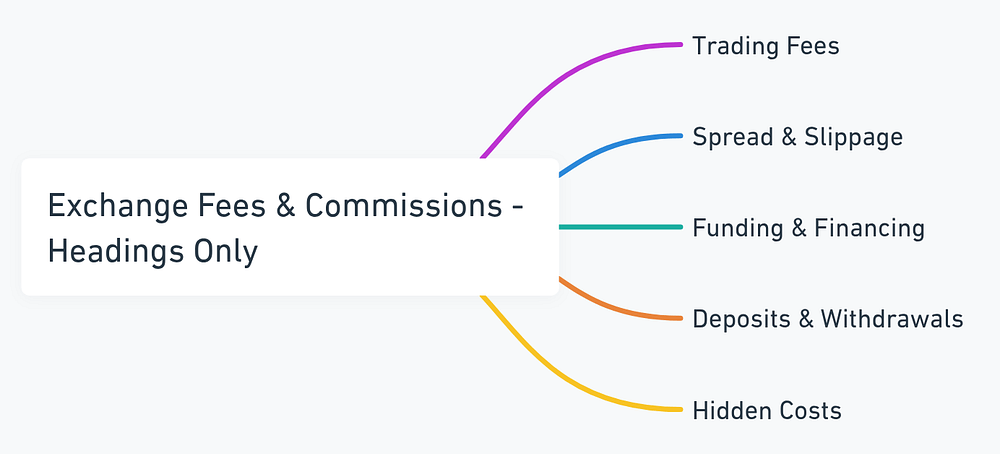
Why it matters
Fees compound. If you scalp or DCA frequently, a small difference in effective cost materially changes outcomes.
How to verify
Simulate a trade end-to-end: quote the pair, size, expected fill price, fee tier, and withdrawal route. For derivatives, model funding for a typical holding period.
Liquidity
- Order-book depth and impact
Examine cumulative depth at 10–50 bps from mid-price on your pairs. Estimate price impact for your typical trade size. - Volume quality
Beware wash-trading. Compare reported volume to third-party trackers and to visible depth; large volume with shallow books is a red flag. - Market coverage and time-zones
Depth can vary by hour; global venues often show 24/7 resilience. - Market-maker programs
Healthy maker incentives correlate with tighter spreads on majors.

Why Liquidity matters
Liquidity determines execution quality, especially during volatility. Deep books and resilient matching engines reduce slippage and gap risk.
How to verify Liquidity
Open the depth chart and Level-2 data for your pairs. Place a tiny limit order inside the spread and watch fill behavior. During a volatile window, check whether spreads blow out or the engine throttles.
Supported coins and pairs
- Listings policy
Transparent criteria (technology review, legal analysis, liquidity plan) indicate diligence. Avoid venues listing every meme without controls. - Base currencies and rails.
fiat currencies and stablecoins are base pairs for your targets? More base options = better routing. - Network support.
If a token exists on multiple chains (e.g., ERC-20 vs. native), which chains are supported for deposits/withdrawals? Mismatches cause delays or extra fees. - Delisting discipline.
Pruning illiquid or risky assets is healthy; sudden mass delistings without rationale are not.
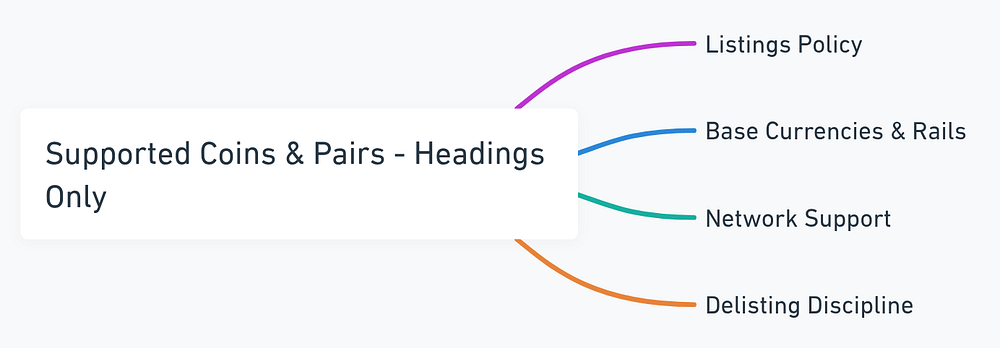
Why it matters
You want reliable access to the assets and chains you actually use, without surprise downtime or forced conversions.
How to verify
Check live markets, deposit/withdrawal pages for chain availability, and historical delisting announcements.
User experience and performance
- Interface quality
Clear order tickets, depth/ trades panes, and error messaging; configurable layouts for advanced users. - Mobile and desktop parity
Can you manage security settings, fiat ramps, and advanced orders on mobile? - Order types and risk tools
OCO/OSO, post-only, reduce-only, trailing stops, conditional triggers, and portfolio margin where applicable. - Speed and stability
WebSocket feeds, low-latency matching, and graceful degradation under load; public status page with uptime history and incident timelines. - APIs and tooling
REST/WebSocket APIs, sandbox environments, rate limits, SDKs, and historical data access for backtesting.
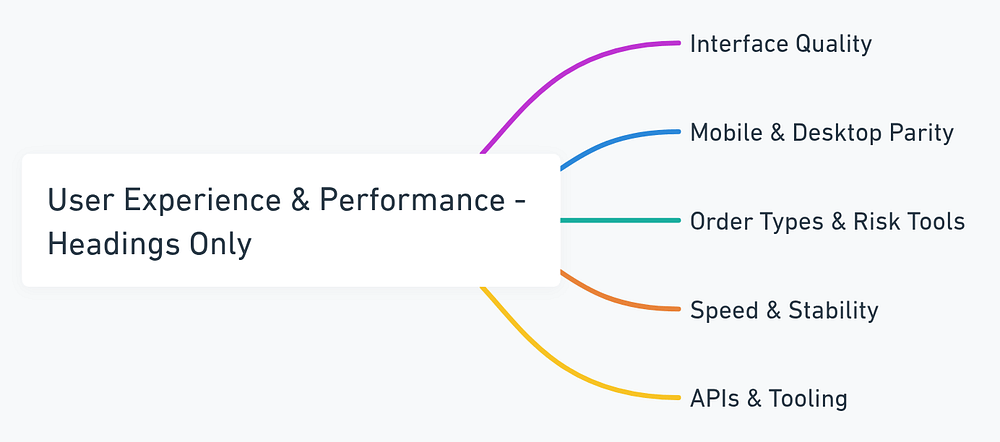
Why it matters
Execution mistakes happen in clunky UIs. A stable, predictable platform reduces operational risk and time-to-decision.
How to verify
Paper-trade in a demo if available, or place tiny live orders during busy periods. Inspect API docs and try a heartbeat/ping.
Regulation and compliance
- Licensing and registrations
Look for region-appropriate permissions (e.g., money services, virtual asset, or investment firm licenses) and named legal entities. - KYC/AML practices
Clear onboarding tiers, source-of-funds policies, and Travel Rule compliance for inter-exchange transfers. - Client asset protections
Segregation from corporate funds, bankruptcy-remote structures where available, and published terms on ownership of assets and staking rewards. - Geographic restrictions
Transparent lists of supported and prohibited jurisdictions; sudden geoblocking is disruptive. - Financial transparency
Attestations, reserve policies, and how they handle stablecoin or yield products.
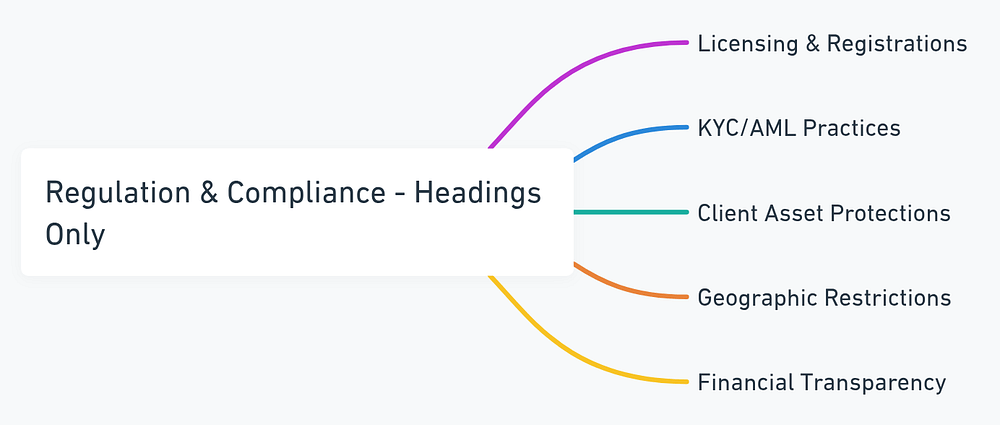
Why it matters
Regulatory posture drives continuity of service and your legal recourse. It also influences product availability (e.g., derivatives, staking).
How to verify
Read the legal/terms pages, compliance disclosures, and regulator registers for the named entity that serves your country.
Customer support
- Channels and SLAs
Live chat, ticketing, phone for high-tier accounts, and published response targets. - Help center quality
Clear, current guides for deposits, chain specifics, and error codes. - Status and comms
Real-time status pages, incident updates with ETAs, and post-incident analyses. - Reputation signals
Resolution rates on public forums, but weigh these cautiously — unhappy users are overrepresented.
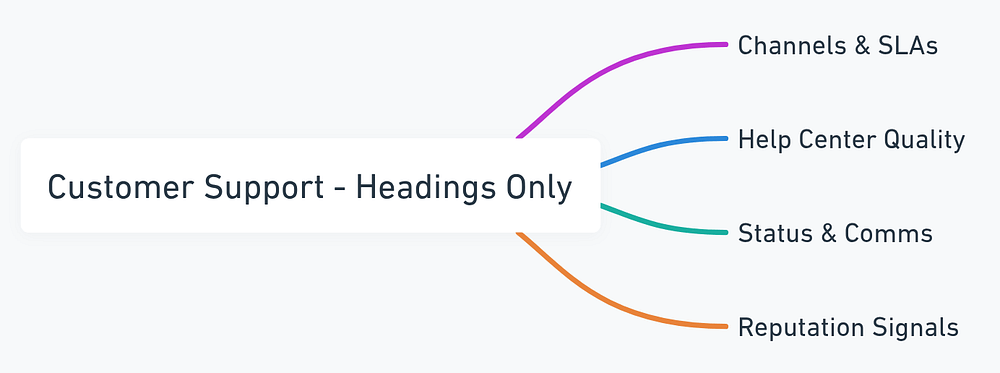
Why it matters
When transfers stall or KYC flags, responsive support can be the difference between hours and weeks.
How to verify
Open a low-stakes ticket (e.g., documentation clarification) and measure response time and accuracy.
Extra features
- Staking and “earn.”
Distinguish on-chain staking (you should see validator details and chain addresses) from off-chain yield programs (credit risk to the exchange or counterparties). Understand lockups and slashing/penalties. - Derivatives
Perpetuals, dated futures, and options. Evaluate margin models, auto-deleveraging (ADL) policies, partial liquidation logic, and circuit breakers. - Margin and lending
Borrow limits, dynamic interest, collateral haircuts, cross vs. isolated margin, and rehypothecation rules. - P2P marketplace
Escrow design, dispute resolution, merchant vetting, and local payment rails. - Copy/social trading
Strategy transparency, risk metrics, and guardrails like max drawdown and stop-copy. - Launchpads and token sales
Vesting, allocation rules, and conflict-of-interest policies. - Tax and reporting
Year-end statements, FIFO/LIFO options, and API export compatibility with tax software.

Why it matters
These features can be valuable — but they add complexity and risk. Treat them as optional layers on top of a solid spot-trading core.
How to verify
Read product-specific docs. Start with minimal sizes and test edge cases: partial fills on perps, early unstake requests, P2P dispute flow.
Putting it together: a quick evaluation workflow
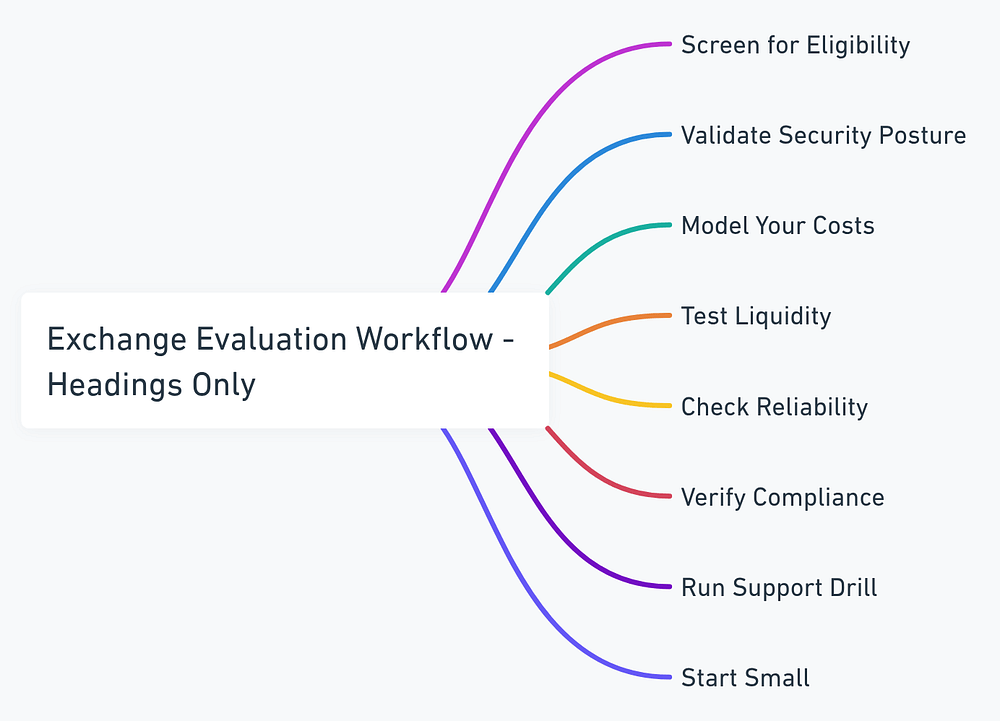
- Screen for eligibility
Confirm your country is supported and products you need are available there. - Validate security posture
Cold-storage design, 2FA/U2F, withdrawal controls, PoR with liabilities context. - Model your costs
Calculate effective costs for your trade sizes and holding periods, including funding/borrow and withdrawals - Test liquidity
Check book depth and place a few tiny orders at busy times. - Check reliability
Read the status page history and one recent incident report - Verify compliance
Confirm licensing/registrations for the entity serving you and asset-segregation language in the terms. - Run support drill
Submit a harmless ticket and time the response. - Start small
Fund with an amount you can tolerate losing while you validate real-world behavior
Best Crypto Trading Exchanges — Conclusion
Selecting the right crypto exchange is as much about risk management as it is about convenience or cost. The best platform for you will depend on your trading style, location, and priorities — whether that’s the lowest fees, the deepest liquidity, or strong regulatory protections.
From this review, a few clear patterns emerge:
- Binance, OKX, and Bybit lead in global liquidity and product diversity for active traders, especially in derivatives.
- Coinbase stands out for regulated access and transparency, making it a strong choice for beginners and compliance-focused users.
- KuCoin, Gate.io, and MEXC excel in altcoin variety, appealing to traders looking for niche or early-stage projects.
- Pionex is unique for integrated automation tools, while BingX and BYDFI shine in copy trading and social features.

No matter which exchange you choose, the key is to treat them as tools, not vaults. Exchanges can offer speed, liquidity, and convenience, but custody should remain in your control whenever possible.
Finally, remember that this industry evolves quickly. Regulations shift, exchange reputations can rise or fall, and new products emerge almost daily. The safest and most profitable traders are those who continuously monitor their platforms, adapt to changes, and do their own research (DYOR) before acting.
FAQ Section
What’s the safest crypto exchange?
No exchange is risk-free, but those with strong regulatory oversight, public Proof-of-Reserves, robust security features, and a long operating history are generally safer. Examples include Coinbase (regulated in the U.S. with audited controls) and Binance (PoR program, SAFU fund, and large-scale security measures). Regardless of exchange, the safest approach is to store long-term holdings in self-custody.
Which exchange has the lowest fees?
Fee structures vary by volume, payment method, and promotions. Binance and MEXC often offer some of the lowest base spot and derivatives fees, especially with token-based discounts. Pionex is notable for its flat 0.05% spot trading fee. Always check the live fee schedule before trading.
Can I use multiple crypto exchanges?
Yes. Many traders use more than one exchange to diversify risk, access unique assets, and take advantage of different liquidity pools or fee tiers. For example, you might trade derivatives on Bybit, hold long-term positions on Coinbase, and chase early altcoin listings on KuCoin.
Is Binance legal in the US?
Binance’s global platform (Binance.com) is not available to U.S. residents. U.S.-based users must use Binance.US, a separate entity that operates under U.S. regulatory frameworks. Availability of features on Binance.US is more limited than on the global exchange.
